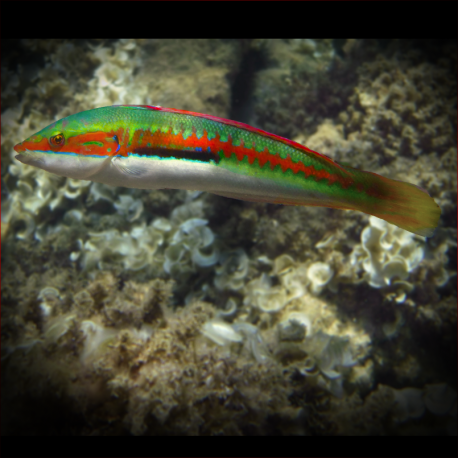More info
Datasheet
| Minimum Tank Size | 1500 litres / 396.26 US gallons |
| Maximum Size | 30.0cm / 11.81inches |
| Reef Compatible | Not reef safe |
| Temperament | Might be aggressive towards other species |
| Temperature | 22.2°C / 71.96°F - 25.6°C / 78.08°F |
| Specific Gravity | 1.020-1.025 |
| Carbonate Hardness | 8-12 |
| pH | 8.1-8.4 |
General Description
The Mediterranean Rainbow Wrasse, scientifically known as Coris julis, belongs to the Labridae family. These wrasses undergo a significant transformation in appearance from juvenile to adult stages. They are known to bury themselves in the substrate when sleeping or feeling threatened, emphasizing the need for a sufficient substrate depth of 2-4 inches (5-10 cm).
Aquarium Suitability and Demands
Considered suitable for aquariums with proper care, these wrasses are recommended for tanks of a minimum size of 1500 liters. They are hardy fish when acclimated as juveniles, although smaller individuals can be delicate. However, they can pose a threat to small fish and are adept hunters of crustaceans, sea urchins, and worms in aquarium settings.
Care and Hardiness
The Mediterranean Rainbow Wrasse is known for its hardiness and requires a varied diet comprising larger and small crustaceans, invertebrates, and other small crustaceans like krill, mysis, and artemia. They are hermaphroditic, with the ability to change from female to male as needed, and prefer hiding initially when acclimating to a new environment.
Reef Suitability
These wrasses are not considered reef-safe due to their tendency to rearrange rocks and substrate. Their foraging behavior for food beneath loose objects can be destructive to reef systems.
Aquarium Setup
When setting up an aquarium for the Mediterranean Rainbow Wrasse, ensure a temperature range of 16-22°C (60-70°F). Provide a deep sandy substrate, securely placed rocks, and ample swimming space. It is crucial to allow them to bury themselves when necessary and offer a peaceful environment to avoid stress.
Behaviour
The species displays territorial and potentially aggressive behavior towards other species, especially smaller fish. They may hide initially and exhibit rock and sand rearrangement tendencies as part of their natural behavior.
Feeding and Diet
To meet their dietary needs, these wrasses require a consistent and varied diet including larger crustaceans, invertebrates, and smaller crustaceans like shrimp, crabs, mysis, and artemia.
Dimorphism and Captive Reproduction
As hermaphroditic fish, Mediterranean Rainbow Wrasses have the ability to change from female to male. Captive reproduction of these wrasses may involve sex changes based on the needs within the group.
Habitat and Distribution
Found in the West Indian Ocean and the Mediterranean Sea, these wrasses inhabit cooler waters compared to typical saltwater aquarium species. They are commonly seen in reef systems, contributing to the ecosystem by preying on unwanted invertebrates such as flatworms and pyramid snails.

